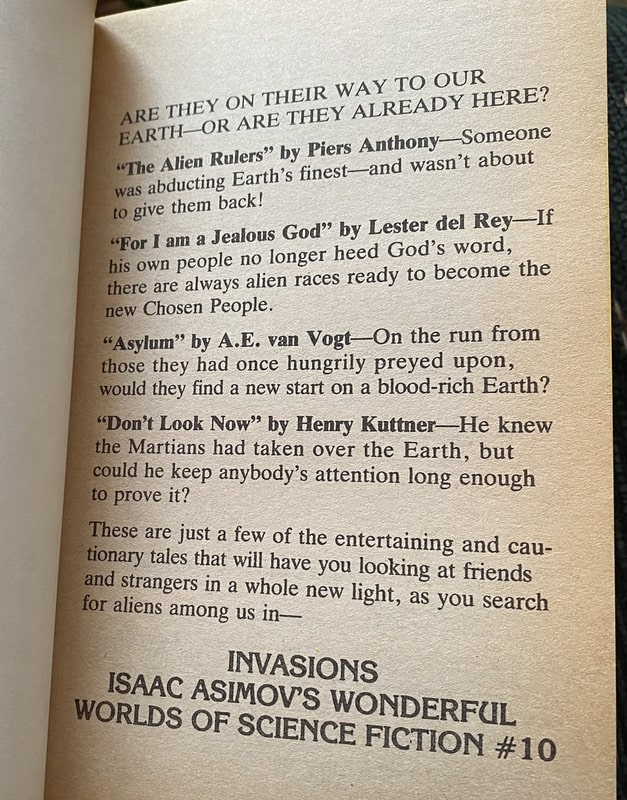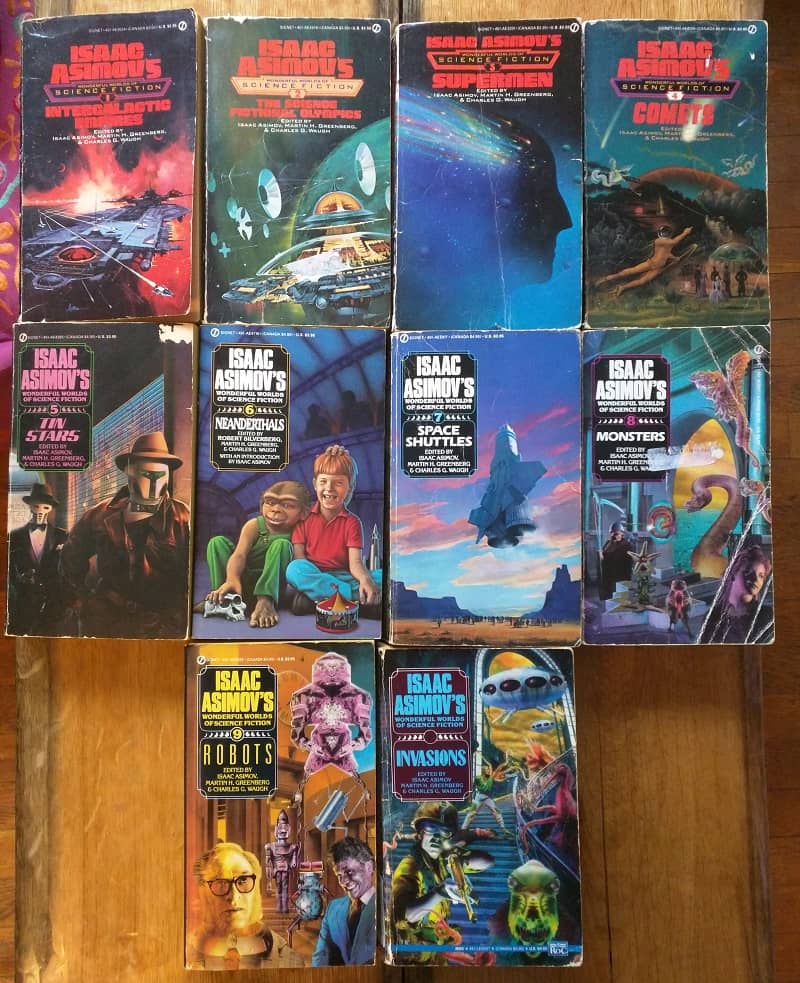Vintage Treasures: Isaac Asimov’s Wonderful Worlds of Science Fiction: Invasions, edited by Isaac Asimov, Martin H. Greenberg, Charles G. Waugh
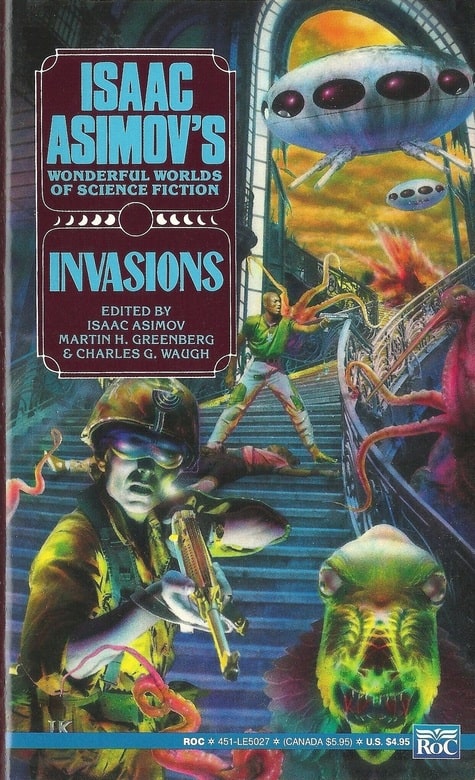 |
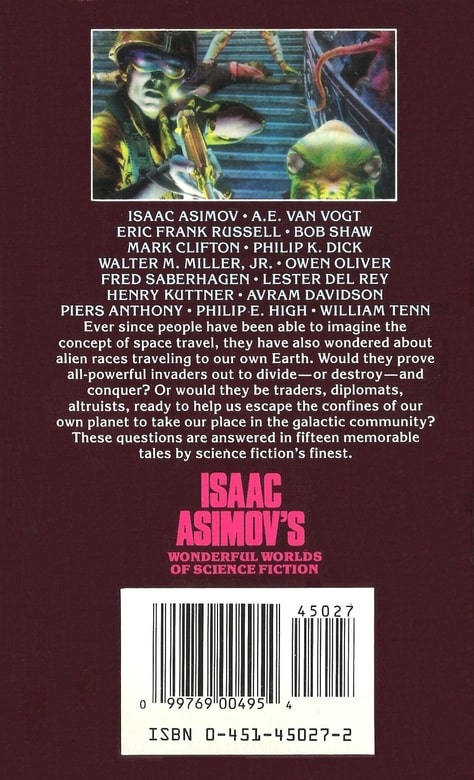 |
Isaac Asimov’s Wonderful Worlds of Science Fiction #10: Invasions (Roc, August 1990). Cover by J.K. Potter
This week we’re looking at Invasions, the tenth and final volume in Isaac Asimov’s Wonderful Worlds of Science Fiction, a paperback original anthology series edited by Isaac Asimov, Martin H. Greenberg, and Charles G. Waugh between 1983 and 1990.
Asimov, Greenberg, and Waugh were an industry unto themselves in the 80s and early 90s. Together they produced some 80 SF anthologies, over half a dozen every year, until Asimov’s death in 1992. In general Waugh made the story selections, Greenberg handled the rights and the contracts, and Asimov wrote the introductions (and lent his name to the series, which ensured robust sales).
The Wonderful Worlds of Science Fiction, a companion series to the 13-volume Magical Worlds of Fantasy by the same editors, was a fun set, with themes like Intergalactic Empires, Tin Stars (robot detectives), Monsters, and Robots. Invasions, which wrapped up the series, containing a Berserker novelette by Fred Saberhagen, novellas by A. E. van Vogt and Lester del Rey, and stories by Philip K. Dick, Eric Frank Russell, Bob Shaw, Walter M. Miller, Jr., Henry Kuttner, Avram Davidson, William Tenn, and many others. It’s a great volume to start with if you’re interested in dipping your toe in 80s anthology collecting.
[Click the images to be invaded by larger versions.]
Inside cover blurb for Invasions
Typical for Asimov, he challenged the whole notion of voracious and sinister alien invaders in his introduction.
As far as we know, no invaders from without have ever reached Earth and, for a variety of reasons, it might be argued that none ever will. However, if they do come, there is no a priori reason to suspect they won’t come in friendship and curiosity, to teach and to learn.
Yet such is the power of humanity’s own shameful history and the conventions of fiction that very few people would be willing to consider alien invaders coming in peace a real possibility. In fact, when plaques and recordings were placed on rocket probes designed to leave the solar system and go wandering off into interstellar space, in order than alien intelligences (if any) might find them someday, millions of years in the future, and that they might thus learn that Earthmen had once existed — there were not lacking those who thought it a dangerous process. Why advertise our existence? Why encourage ferocious aliens to come here in order to ravage and destroy?
Asimov, who steadfastly avoided writing anything as predictable as an alien invasion story in his career, was probably the least-likely candidate to be included herein, so I was surprised to see a contribution from him in the TOC (“Living Space,” originally published in Science Fiction Stories in 1956).
Randy Stafford has the best review I’ve seen of Invasions, posted on LibraryThing in 2014. Here’s an excerpt.
“Living Space” Isaac Asimov — A very Asimov story. Earth is run by a technocracy which thinks it has solved the problem of overpopulation (one of Asimov’s lifelong concerns) by putting people in alternate, uncrowded Earths. These alternate Earth settlements and the commutes to them via a “twisting place” in this 1956 story were obviously inspired by the great post-World War II flight to the suburbs in America. This story is also a bit of an alternate history since the protagonist meets up with an inhabitant of a world where Hitler was victorious…
“Exposure” Eric Frank Russell — An enjoyable joke story with a reconnaissance party of shapeshifting aliens (Russell gets a lot of humor from the aliens’ custom of trying to match their Captain Id-Wan’s form as custom dictates) being thwarted in their exploration of Earth by landing in a nudist colony and thinking its inhabitants are normal and worthy of imitation.
“Invasion of Privacy” Bob Shaw — Interesting story of a quiet alien invasion. The invaders only assume (and the nature of the invaders’ home or their exact relationship to humanity is unrevealed) the identity’s of those who have already died. The narrator, at story’s end, cooperates with this quiet invasion (he doesn’t even know how many alien impersonators are on Earth) since his wife is given an ersatz son to replace one who has died…
“What Have I Done?” Mark Clifton — A rather fun story that takes a decidedly cynical twist at the end. The narrator runs an employment agency and prides himself on his ability to read people. He comes across (one applies at his employment agency) an alien race bent on taking over the Earth and letting the human race die out. (The aliens are facing overpopulation on their planet. This 1952 story is another example of that decade’s sf concern with that theme.) The aliens can’t seem to understand how we could object to so logically motivated and humanely executed extinction, and they ask the narrator to help them impersonate humans. He moves them out to Hollywood, where their eccentricities won’t be noticed, and begins the lessons…
“For I Am a Jealous People!” Lester del Rey — This story is one of those rare sf stories that takes a religious premise as literally true. Here the premise is that the Judeo-Christian God of the Old Testament really did make a covenant with man — and has revoked it and made a covenant with a conquering, savage alien race (who often tortures their human victims). The hero is a sympathetically treated Christian minister who tries to succor and tend to the victims of the aliens while losing his family…
“Don’t Look Now”, Henry Kuttner — This story, with its explicit reference to Charles Fort, is the reason I read this anthology. It’s a fun story with various illogical behaviors of man, everything from war to listening to the radio, being motivated by the parasitic presence of an invisible race that co-evolved with man and kept its presence secret. (They got the upper hand on us when we were still apes.) Unlike Eric Frank Russell’s earlier Fortean-inspired Sinister Barrier, (this is a 1948 story), the invisible entities are roughly humanoid. However, both stories have the presence of the parasites being revealed through advances in infrared photography…
“The Certificate”, Avram Davidson — A short, very grim story of the aftermath of alien conquest. Doomed to a Metropolis-like existence of pulling levers on machines of enigmatic purpose, we think the protagonist is petitioning, in this dictatorial, Soviet-like existence of crowded dormitories, to somehow be allowed to leave. Then the grim truth is revealed…
“Squeeze Box” Philip E. High… This biter-bitten story of humanity casting off the yoke of alien oppression could have been longer. There are several references to classical mythology in the story, and the basic plot of humanity gaining the help of the alien (and, it turns out, very advanced) zipcats because a human shows kindness to a trapped zipcat cub is much like the story of Androcles and the lion…
“The Liberation of Earth” William Tenn — This is the second time I’ve read this delightful, witty story, complete with future slang. The first time around I got that it was obviously a satire on the political relations of the superpowers to Third World countries during the Cold War. This time I think that Marxist Tenn was specifically reacting, in this 1953 story, to the Korean War.
Altogether there were ten volumes in Isaac Asimov’s Wonderful Worlds of Science Fiction, and they make a fine addition to any science fiction library.
All ten volumes in the series
Here’s all ten volumes.
1 Intergalactic Empires (1983)
2 The Science Fictional Olympics (1984)
3 Supermen (1984)
4 Comets (1986)
5 Tin Stars (1986)
6 Neanderthals (1987)
7 Space Shuttles (1987)
8 Monsters (1988)
9 Robots (1989)
10 Invasions (1990)
The first nine were published as paperback originals by Signet; Invasions is the only one to appear under the Roc banner. None have been reprinted.
Here’s the complete Table of Contents for Invasion.
Introduction by Isaac Asimov
“Living Space” by Isaac Asimov (Science Fiction Stories, May 1956)
“Asylum” by A. E. van Vogt (Astounding Science-Fiction, May 1942)
“Exposure” by Eric Frank Russell (Astounding Science Fiction, July 1950)
“Invasion of Privacy” by Bob Shaw (Amazing Science Fiction, July 1970)
“What Have I Done?” by Mark Clifton (Astounding Science Fiction, May 1952)
“Impostor” by Philip K. Dick (Astounding Science Fiction, June 1953)
“The Soul-Empty Ones” by Walter M. Miller, Jr. (Astounding Science Fiction, August 1951)
“The Cloud-Men: Being a Foreprint from the London News Sheet #1” by Owen Oliver (Munsey’s Magazine, v45 #5, August 1911)
“Stone Man” by Fred Saberhagen (Worlds of Tomorrow, May 1967)
“For I Am a Jealous People!” by Lester del Rey (Star Short Novels, October 1954)
“Don’t Look Now” by Henry Kuttner (Startling Stories, March 1948)
“The Certificate” by Avram Davidson (The Magazine of Fantasy and Science Fiction, March 1959)
“The Alien Rulers” by Piers Anthony (Analog Science Fiction/Science Fact, March 1968)
“Squeeze Box” by Philip E. High (New Worlds Science Fiction #81, March 1959)
“The Liberation of Earth” by William Tenn (Future Science Fiction, May 1953)
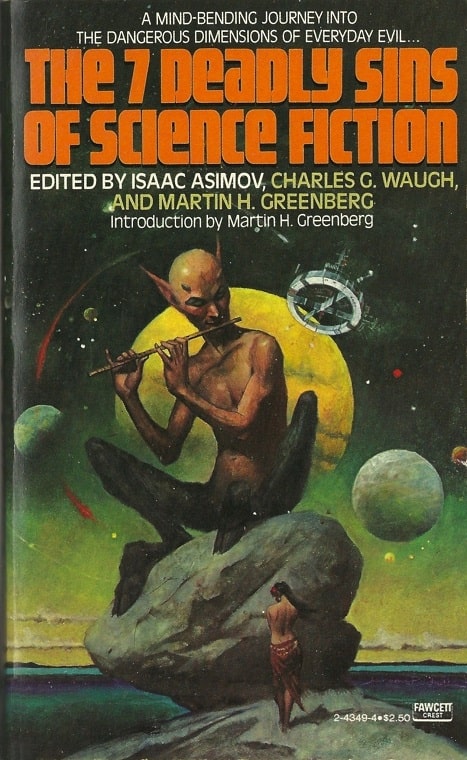 |
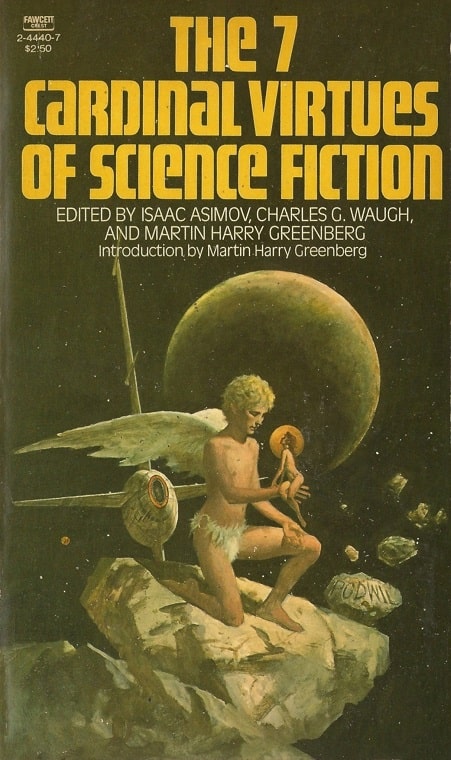 |
The Seven Deadly Sins of Science Fiction and The Seven Cardinal Virtues of Science Fiction
(Fawcett Crest, 1980 and 1981). Covers by Jerome Podwil
Our previous coverage of anthologies by Isaac Asimov, Martin H. Greenberg, and Charles G. Waugh includes:
The Seven Deadly Sins of Science Fiction
Isaac Asimov’s Wonderful Worlds of Science Fiction 1: Intergalactic Empires
Isaac Asimov’s Wonderful Worlds of Science Fiction 5: Tin Stars
Isaac Asimov’s Magical Worlds of Fantasy 10: Ghosts
13 Short Fantasy Novels, 13 Short Science Fiction Novels, and 13 Short Horror Novels
We’ve also discussed a few highly enjoyable volumes produced without Asimov’s input, from Waugh, Greenberg, and others.
The Space Anthologies, edited by David Drake with Charles G. Waugh and Martin Harry Greenberg
The Tomorrow’s Warfare Anthologies, edited by Joe Haldeman, Charles G. Waugh, and Martin Harry Greenberg
Invasions was published by Roc in August 1990. It is 384 pages, priced at $4.95 in paperback. The cover is by J.K.Potter. The book has never been reprinted, and there is no digital edition.
See all our recent Vintage Treasures articles here.
